Convenience Store Market Size
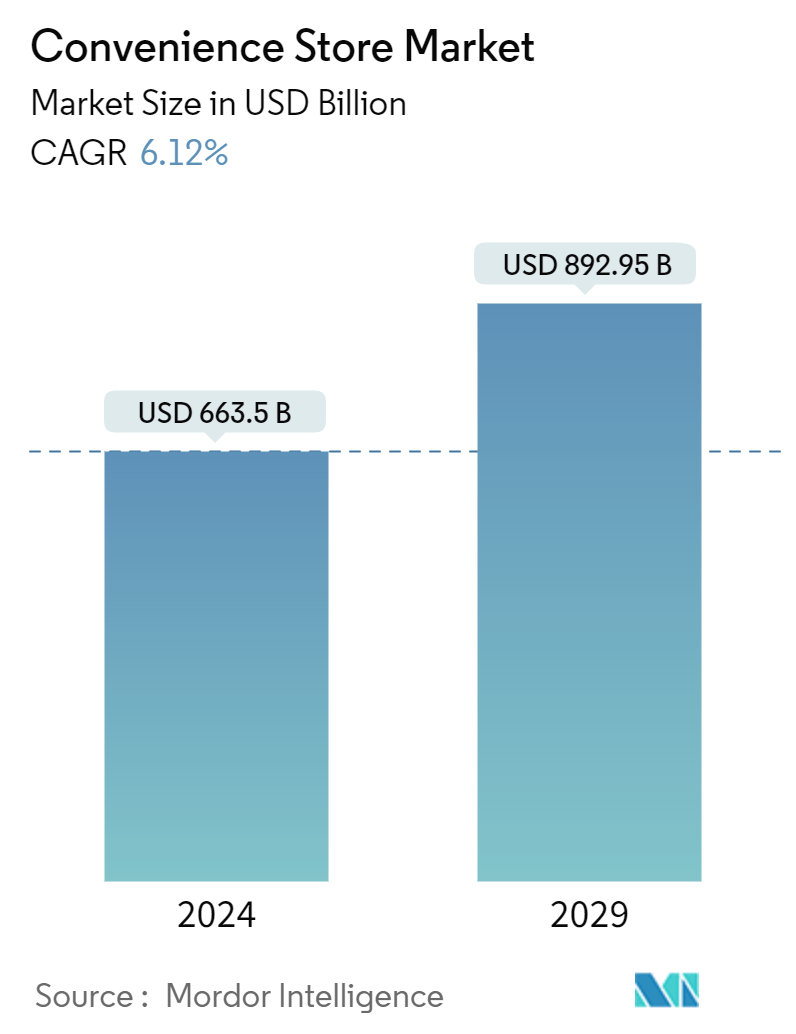
| Study Period | 2020 - 2029 |
| Base Year For Estimation | 2023 |
| Market Size (2024) | USD 663.5 Billion |
| Market Size (2029) | USD 892.95 Billion |
| CAGR (2024 - 2029) | 6.12 % |
| Market Concentration | Low |
Major Players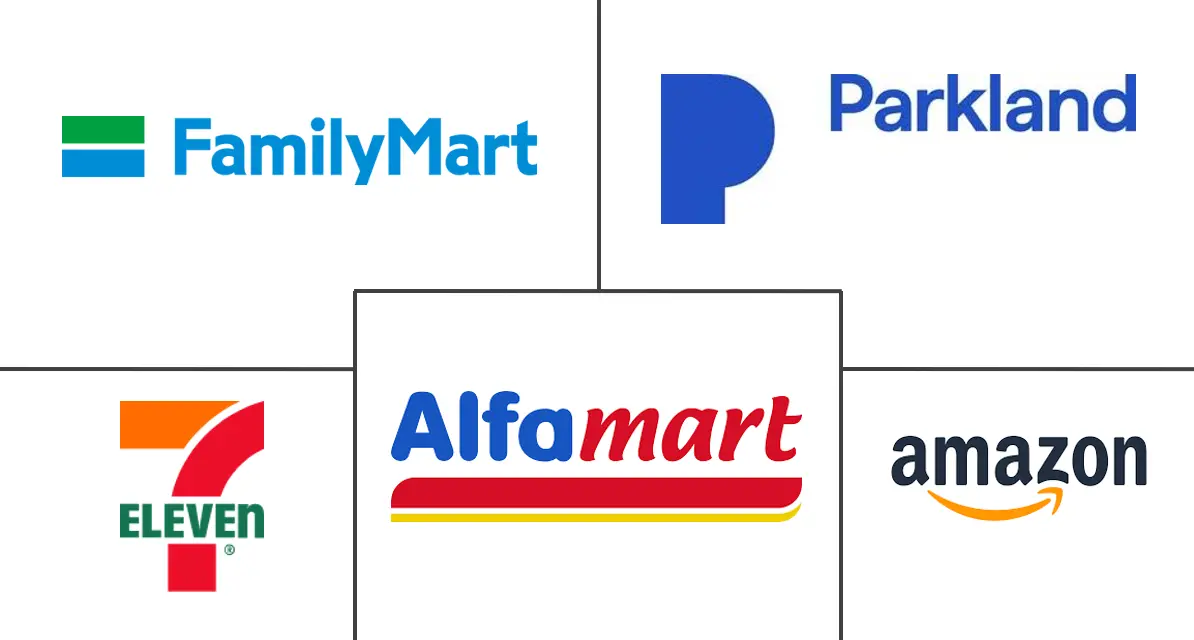
*Disclaimer: Major Players sorted in no particular order |
Convenience Store Market Analysis
The Convenience Store Market size is estimated at USD 663.5 billion in 2024, and is expected to reach USD 892.95 billion by 2029, growing at a CAGR of 6.12% during the forecast period (2024-2029).
The global convenience store industry is expanding, meeting the demands of time-pressed customers who appreciate easy access to necessities and convenience. Convenience stores are ubiquitous across nearly all nations, providing diverse products and services. In many countries, convenience stores are an integral part of daily life. They allow people to grab snacks, beverages, basic groceries, and other daily necessities without visiting larger supermarkets. The extended operating hours of convenience stores make them accessible even during evenings and weekends when other stores may be closed.
The global population and population density are continuously rising; existing retail convenience stores are rising to meet the increasing demand. A convenience store provides easy access to products from nearby stores, and with some stores opening 24 hours a day, customers can access their products when needed. One of the critical advantages of convenience stores is their strategic locations. They are often found in residential areas, near transportation hubs, or in commercial districts, facilitating their easy accessibility to a diverse clientele. In recent years, technology has also had a big impact on the convenience store industry. Some stores have implemented self-checkout systems, contactless payment options, and mobile apps for seamless shopping experiences.
Convenience Store Market Trends
Rise in Sales of Convenience Store
The rise in sales at convenience stores can be attributed to a combination of factors, including changing consumer preferences, expanded product offerings, technology integration, effective promotional strategies, and broader societal trends. Consumers are increasingly seeking convenience in their shopping experience, preferring quick and easy access to essential items. Convenience stores, with their extended hours and proximity to residential areas, cater well to this need. Additionally, convenience stores have expanded their product offerings beyond traditional items like snacks and beverages to include fresh food, ready-to-eat meals, and basic groceries. This diversification has attracted more customers and increased sales. Moreover, many convenience stores are now offering healthier food and beverage options, catering to the growing demand for nutritious choices. This has helped boost sales, especially among health-conscious consumers
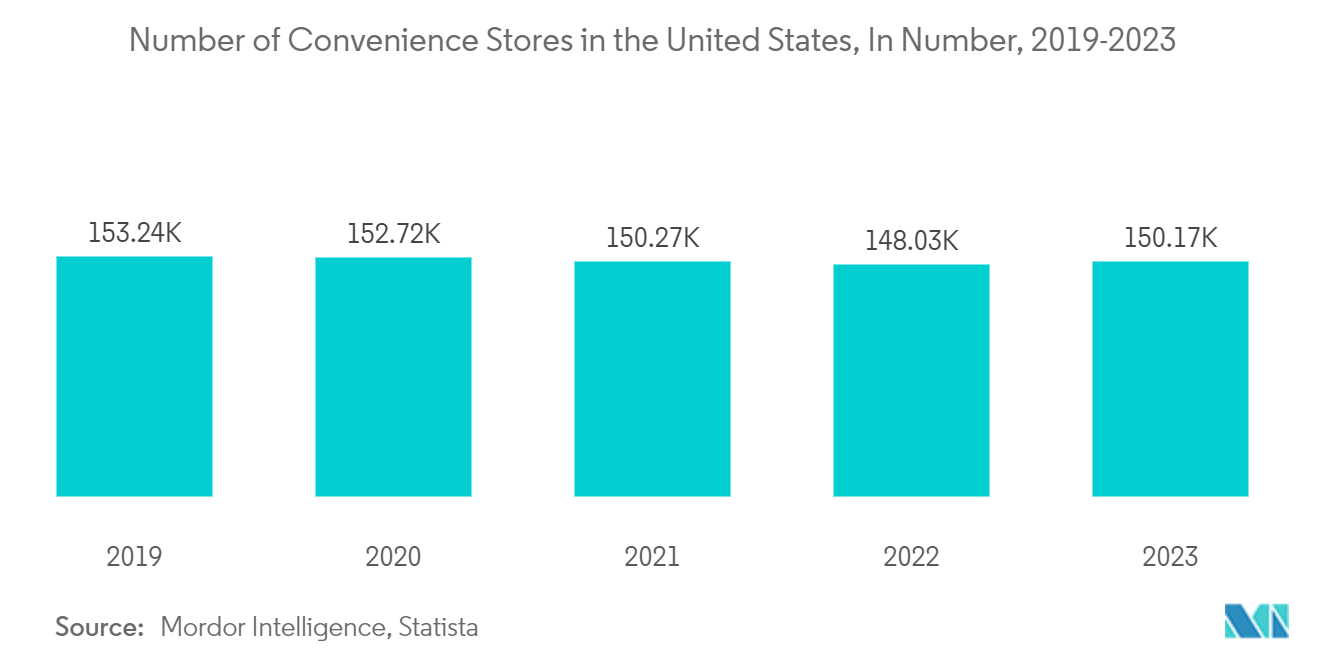
Asia Pacific is the Fastest Growing Market
The convenience store market in the Asia-Pacific region is undergoing substantial growth, fueled by key factors. Rapid urbanization is driving more individuals to live in cities, where convenience stores are easily accessible and tailored to urban lifestyles. Additionally, convenience store chains are introducing innovative store formats, like small-format stores in busy areas, to meet diverse consumer needs and enhance convenience.
The surge in convenience store demand is attributed to the rising purchasing power of the middle class in China and Vietnam. Lifestyle shifts and the adoption of fast-paced living have particularly fueled the rapid growth of convenience stores in urban areas of Vietnam. Additionally, as infrastructure improves, the proliferation of outlets gains momentum, further boosted by collaborative agreements among local businesses, driving overall market expansion.
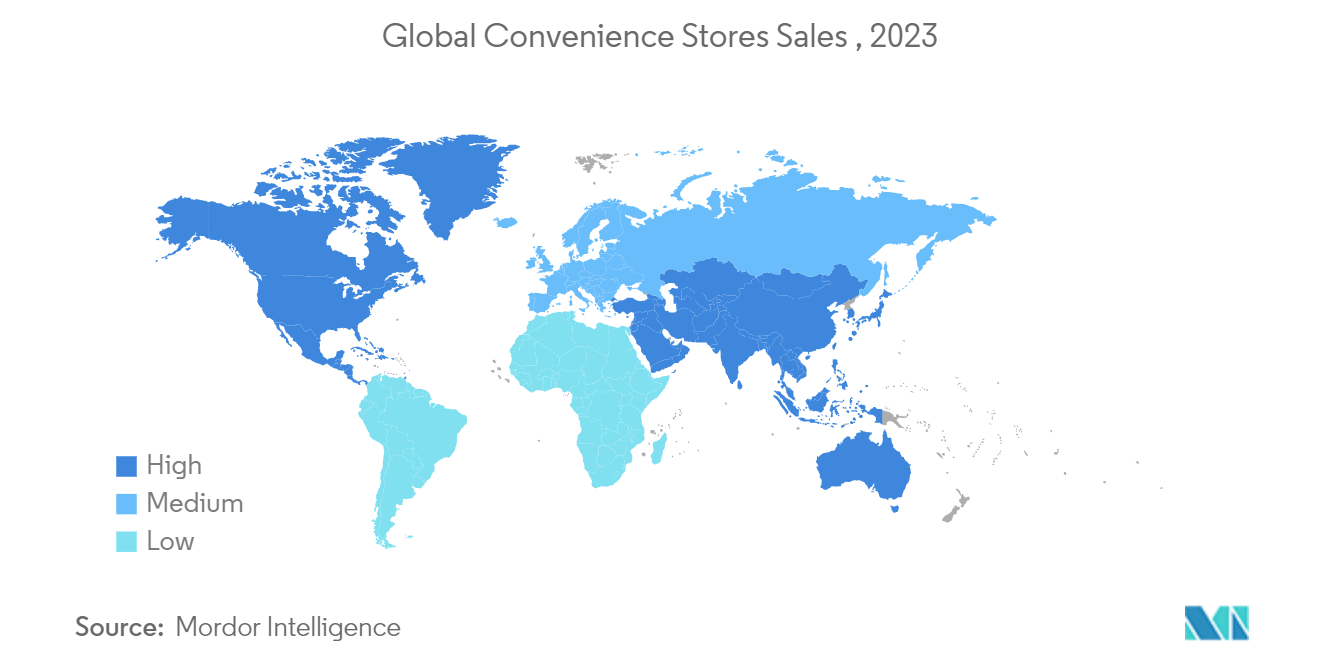
Convenience Store Industry Overview
With the amount of capital required, a large number of independent convenience stores are emerging globally, other than convenience store chains. Convenience stores are providing customers with fresh products, which is resulting in an increase in foot traffic towards these stores. Among the largest and leading convenience stores globally, there are 7-Eleven, Easy Joy, Family Mart, Meiyijia, uSmile, OXXO, Indomaret, Alfamart, Pyaterochka, and Magnit, with their leadership in the market and large customer and market shares.
Convenience Store Market Leaders
-
Parkland Corporation
-
Family Mart
-
7 Eleven
-
24 SEVEN
-
Alfamart
*Disclaimer: Major Players sorted in no particular order
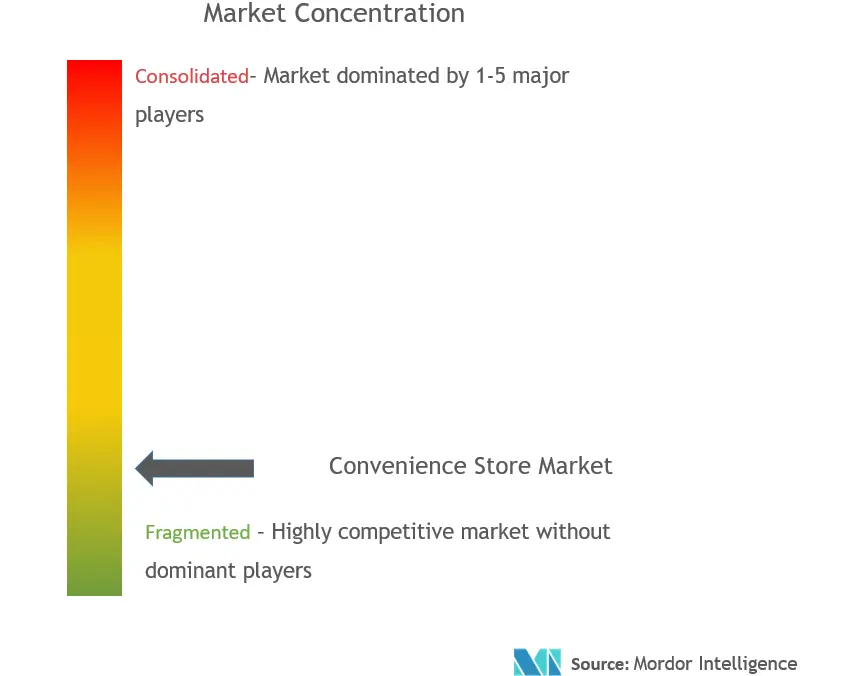
Convenience Store Market News
- In January 2024, 7-Eleven, Inc. disclosed its agreement to purchase 204 stores from Sunoco LP, encompassing both Stripes convenience stores and Laredo Taco Company restaurants.
- In November 2023, Casey's General Stores revealed its intention to purchase 22 Lone Star Food Stores in North Texas from W. Douglass Distributing Ltd.
- In December 2023, Casey's completed the acquisition of 11 EZ Go-branded convenience stores from Love's Travel Stops & Country Stores in Oklahoma and Nebraska. These stores are set to undergo rebranding to align with the Casey's retail brand.
Convenience Store Market Report - Table of Contents
1. INTRODUCTION
- 1.1 Study Assumptions and Market Definition
- 1.2 Scope of the Study
2. RESEARCH METHODOLOGY
3. EXECUTIVE SUMMARY
4. MARKET DYNAMICS AND INSIGHTS
- 4.1 Market Overview
- 4.2 Market Drivers
- 4.3 Market Restraints
- 4.4 Industry Value Chain Analysis
-
4.5 Industry Attractiveness - Porter's Five Forces Analysis
- 4.5.1 Bargaining Power of Buyers
- 4.5.2 Bargaining Power of Suppliers
- 4.5.3 Threat of New Entrants
- 4.5.4 Threat of Substitutes
- 4.5.5 Intensity of Competitive Rivalry
- 4.6 Insights of Technology Innovations in the Market
- 4.7 Impact of COVID-19 on the Market
5. MARKET SEGMENTATION
-
5.1 By Product types
- 5.1.1 Staple Products
- 5.1.2 Impulse Products
- 5.1.3 Emergency Products
-
5.2 By Store Types
- 5.2.1 Kiosks
- 5.2.2 Mini Convenience Stores
- 5.2.3 Limited Selection Convenience Stores
- 5.2.4 Traditional Convenience Stores
- 5.2.5 Expanded Convenience Stores
- 5.2.6 Hyper Convenience Stores
-
5.3 By Region
- 5.3.1 North America
- 5.3.2 Latin America
- 5.3.3 Europe
- 5.3.4 Middle East and Africa
- 5.3.5 Asia-Pacific
6. COMPETITIVE LANDSCAPE
- 6.1 Market Concentration Overview
-
6.2 Company Profiles
- 6.2.1 7-Eleven
- 6.2.2 Easy-Joy
- 6.2.3 Family Mart
- 6.2.4 Meiyijia
- 6.2.5 uSmile
- 6.2.6 OXXO
- 6.2.7 Indomaret
- 6.2.8 Alfamart
- 6.2.9 Pyaterochka
- 6.2.10 Magnit
- *List Not Exhaustive
7. MARKET OPPORTUNITIES AND FUTURE TRENDS
8. DISCLAIMER AND ABOUT US
** Subject To AvailablityConvenience Store Industry Segmentation
A convenience store is a retail shop that makes available essential goods consisting of groceries like eggs, bread, butter, and milk, over-the-counter medicines, soft drinks, etc., with a few convenience stores selling limited alcohol products.
The convenience store market is segmented by product types, store types, and region. By product types, the market is sub-segmented into staple products, impulse products, and emergency products. By store types, the market is sub-segmented into kiosks, mini convenience stores, limited selection convenience stores, traditional convenience stores, expanded convenience stores, and hyper convenience stores. By region, the market is sub-segmented into North America, Latin America, Europe, the Middle East and Africa, and Asia Pacific.
The report offers market size and forecasts for the convenience store market in value (USD) for all the above segments.
| By Product types | Staple Products |
| Impulse Products | |
| Emergency Products | |
| By Store Types | Kiosks |
| Mini Convenience Stores | |
| Limited Selection Convenience Stores | |
| Traditional Convenience Stores | |
| Expanded Convenience Stores | |
| Hyper Convenience Stores | |
| By Region | North America |
| Latin America | |
| Europe | |
| Middle East and Africa | |
| Asia-Pacific |
Convenience Store Market Research Faqs
How big is the Convenience Store Market?
The Convenience Store Market size is expected to reach USD 663.5 billion in 2024 and grow at a CAGR of 6.12% to reach USD 892.95 billion by 2029.
What is the current Convenience Store Market size?
In 2024, the Convenience Store Market size is expected to reach USD 663.5 billion.
Who are the key players in Convenience Store Market?
Parkland Corporation, Family Mart, 7 Eleven, 24 SEVEN and Alfamart are the major companies operating in the Convenience Store Market.
What years does this Convenience Store Market cover, and what was the market size in 2023?
In 2023, the Convenience Store Market size was estimated at USD 622.89 billion. The report covers the Convenience Store Market historical market size for years: 2020, 2021, 2022 and 2023. The report also forecasts the Convenience Store Market size for years: 2024, 2025, 2026, 2027, 2028 and 2029.
What are the major market trends in the Convenience Store Market?
The major market trends in the Convenience Store Market are a) Emphasis on digital transformation: mobile payment options, self-checkout and inventory management systems b) Growing importance of private label brands c) Focus on sustainability: reducing plastic waste and offering eco-friendly packaging options
Convenience Store Industry Report
The global convenience stores market is segmented by product types, store types, and regions, offering detailed market size and forecasts in volume and value. With a significant market share in North America, the industry is experiencing rapid growth. The Asia-Pacific region is noted for its swift market expansion due to urbanization, lifestyle changes, and increased purchasing power in countries like China and Vietnam.
Key market trends include strategic placement in densely populated areas, extended operation hours, and the rising demand for quick access to necessities. Digital adaptations such as mobile payments and self-checkout systems are enhancing the market dynamics. Partnerships with delivery services like Uber Eats are also playing a crucial role in the market growth.
Despite challenges like urban real estate costs, the industry thrives by offering vital access to goods in busy urban settings, serving both emergency and daily needs. For further insights, detailed industry reports including forecasts and historical overviews are available for download.
Industry analysis reveals that the market size, market share, and industry growth are significant factors driving the industry. The market overview shows a strong demand for convenience, supported by industry statistics and sales data. The market forecast indicates continued growth, influenced by industry trends and market trends. The industry outlook remains positive, with market value and industry revenue showing promising signs.
The report example and report PDF provide comprehensive industry research, including market analysis and industry information. Market segmentation and market review highlight the various aspects of the market, while industry reports and market reports offer detailed insights. Market predictions and market leaders are identified, providing a clear view of the future market landscape.
Overall, the convenience store market is poised for continued growth, supported by robust market data and industry research. The market outlook remains optimistic, with industry sales and market growth expected to rise. Industry trends and market predictions indicate a strong future for the convenience store market, making it a key area of interest for research companies.



